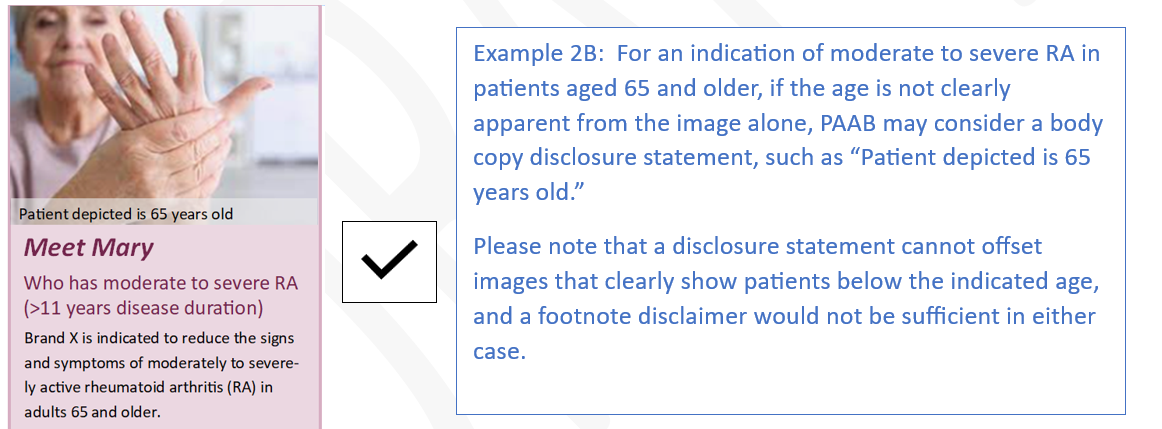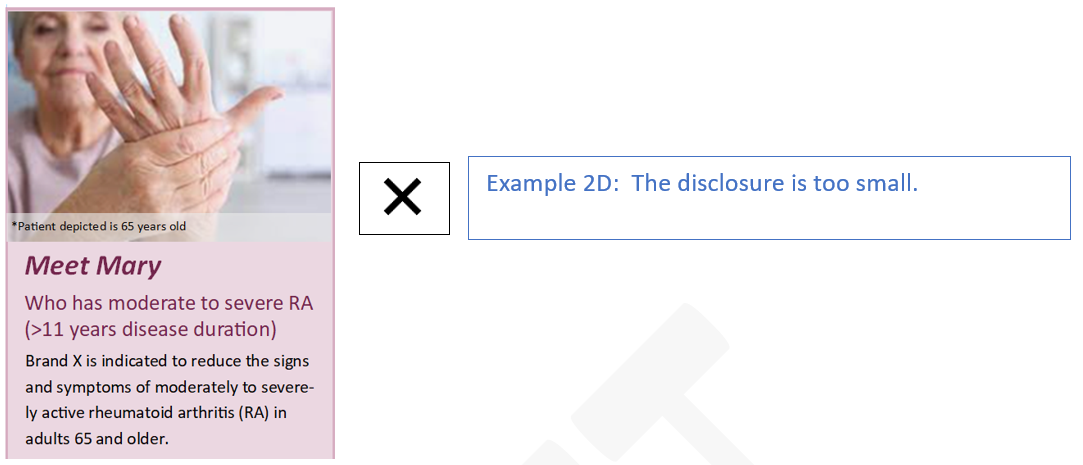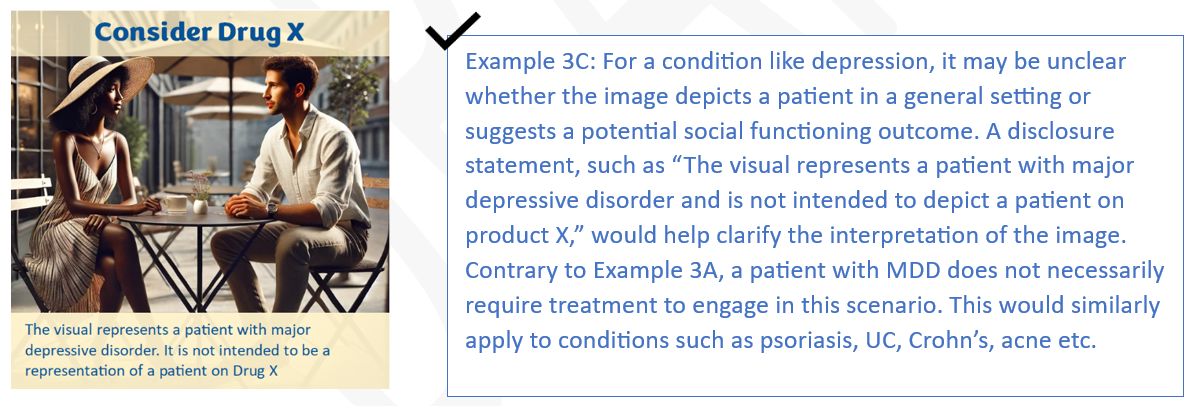**DRAFT**
The following document is in draft stage. PAAB will be accepting feedback from all stakeholders until December 2nd (downloadable PDF at the bottom). The feedback will be anonymized and presented to the Creative Committee for consideration of additional changes prior to finalization. We'd like to encourage stakeholders to consolidate feedback from their respective organizations and send to info@paab.ca. You can learn more about the process that got to this document at Creative Imagery Committee.
Thank you!
Date: November 12, 2024
Creative imagery/concepts are core messages for APS. Similar to the “Guidance on the Presentation of Burdens of Disease in Advertising”, the PAAB endeavours to ensure the credibility of evidence-based drug advertising and it is important that benefits that have not been demonstrated by a drug product are not implicitly imputed to it. In our effort to expand the range of acceptable use of creative imagery in advertising, we are aiming for an approach that balances utility and credibility.
The focus of this guidance is to provide information on the PAAB considerations when reviewing creative imagery.
General Factors for Consideration:
When assessing creative imagery/concepts, PAAB considers the overall message and its components (e.g. copy, image, etc.) in addition the therapeutic area and supporting data. Each of these elements contribute to the context of the message and how it will be interpreted. See Appendix 1 for requirements that remain unchanged by the guidance in this document.
Main Types of Messages in APS
The following are 4 main types of messages that are seen in pharmaceutical advertising at PAAB. The list is not exhaustive, but it serves as examples to help clarifying the PAAB considerations.
These creative concepts are straightforward and therefore do not require further clarification in this document. Please ensure that the images do not contain elements that imply unsupported claims. Such elements may include hand gestures (e.g., thumbs up, pointing to indicate “#1”), displays of intense emotions0F[1] (e.g., extreme exuberance), or specific accessories (e.g., a “#1 Dad” t-shirt, ribbons, or medals).
Example 1:

[1] In advertising, emotional extremes are depicted by showcasing highly intense emotions—either positive or negative—to capture attention and create a strong emotional response from the audience. These depictions often highlight exaggerated joy, excitement, or satisfaction to promote a product's benefits, or intense fear, sadness, or frustration to emphasize the consequences of not using a product or service.
Creatives that clearly depict the indicated condition are straightforward, such as visuals that reflects any stage of a condition reflected in the indication (e.g., "In moderate to severe RA, consider Drug X...").
For visuals that are ambiguous, PAAB may consider allowing a disclosure statement to clarify the intent of the image, along with a medical/regulatory attestation letter confirming this intent. The disclosure should be prominent and included in the body copy. Note that disclosure statements belong in the body copy.
NOTE: This document provides guidance on reviewing images and creative concepts in general; it does not cover all PAAB requirements for an acceptable APS. All relevant PAAB Code requirements will need to be met in formal submissions.
Example 2:




Note: When assessing prominence, look to the PAAB Advisory - Small Space Ads document and examples for consideration of contrast, proximity, font size etc.
For creatives depicting disease burdens related to the condition but which are not specified in the indication and do not have supporting product data, please see the Guidance on the Presentation of Burdens of Disease in Advertising for further direction.

These types of creative elements can be interpreted in various ways depending on factors like therapeutic context, supporting data, and more. Images and copy may imply potential outcomes for the brand, or depict a patient in a general life setting, or sometimes be unclear.
For creative material where it is not obvious which message the image depicts, a disclosure can help clarify the intended message. To guide interpretation, PAAB may consider prominent disclosures in the body copy, such as “The visual represents a patient with condition Y and is not intended to depict a patient on product X,” or similar statements where appropriate.



(Please see Appendix 2 for additional examples)
Creatives that depict an explicit or implicit outcome require substantiation and inclusion of the supporting data within the APS itself. The supporting data is required to be on the page in body copy with the creative to provide adequate qualification. Clearly presenting the extent of benefits demonstrated in studies allows health professionals to make informed risk-benefit assessments, essential for rational prescribing or recommending of treatments.
4.a: Outcome messages:

4.b: Quality of life messages:
A key challenge with creative images is that they often convey implicit messages about improvements in quality of life, functionality, activity levels, or performance. Frequently, these images go beyond simply depicting a patient in a general lifestyle setting and instead imply specific outcomes or benefits. Whether an image crosses into claiming an outcome depends on several factors described above. Below are examples of images and the contextual factors that influence their acceptability:
| Example 5A | Unacceptable context | |
 |
Therapeutic area: ADHD
Accompanying text: Increase concentration and productivity
Perceived message: Drugs X will increase productivity multifold.
TMA/ Supporting data: Indication, no productivity/work data
Rationale: The image implies increased or exponential productivity without supporting data. Data would be required for such claims and the magnitude of effect conveyed would need to reflect the respective data. |
|
| Example 5B(i) | Acceptable context | Unacceptable context |
 |
Therapeutic area: Hypercholesterolemia
Accompanying text: What can Drug X do for Suzy?
Perceived message: Drug X can be used in patients like Suzy.
TMA/ supporting data: Indication, no work productivity data. Rationale: Having high cholesterol would not generally impact a patient’s ability or desire to perform office work. The indication for hypercholesterolemia would be sufficient as support. |
Therapeutic area: General Anxiety Disorder
Accompanying text: Suzy’s back!
Perceived message: Drug X can return Suzy back to her previous functioning state.
TMA/ Supporting data: Indication, no work productivity data. Rationale: Physical and mental functioning impairments are key aspects of GAD's clinical presentation and are used in outcome assessments. Any message suggesting a return to work would require specific supporting clinical data. |
Combining Rationales:
In example 5B(i), the copy “Suzy’s back!” sets a context that the product helped Suzy return to work (an outcome). If the context were revised to “Think Brand X” to remove the explicit link to clinical outcomes, the implicit claim can be managed through the addition of a disclosure statement per Section 3.
Example 5B(ii)

| Example 5C | Acceptable context | Acceptable context | Unacceptable context |
 |
Therapeutic area: ADHD
Accompanying text: Think Drug X for your ADHD patients
Perceived message: ADHD patient in a general setting
TMA/ Supporting data: Indication only Rationale: ADHD does not generally impact a patient’s ability to sit in front of a computer. Importantly, the context does not convey that he has been sitting still and attentively for a substantial period. There is no inference of how the patient is using the computer or if there is a relationship to quality of life. The indication would be sufficient as support. |
Therapeutic area: Carpal tunnel syndrome
Accompanying text: Have you considered Drug X for their carpal tunnel syndrome?
Perceived Message: Drug X can be used in this patient.
TMA/ Supporting data: Indication, no function or productivity data
Rationale: This is a carpal tunnel patient sitting at a computer. We cannot see their face, so we do not know if they are experiencing pain. They are existing in a general setting. The indication would be sufficient as support. |
Therapeutic area: Carpal tunnel syndrome
Accompanying text: Don’t let carpal tunnel slow you down.
Perceived message: Improved function to continue productivity
TMA/ Supporting data: Indication, no function or productivity data, pain data Rationale: The visual with the heading has implications for productivity for which the product does not have data to support. The statement for “slow you down” also has implications for quality of life that would require data. |
| Example 5D | Acceptable context | Unacceptable context |
 |
Therapeutic area: Thrombocytopenia
Accompanying text: “Consider Drug X for their treatment journey”
Perceived message: Drug X can be used in this patient
TMA/ Supporting data: Indication, no data for function or quality of life. Rationale: The general presentation of thrombocytopenia does not generally impact a patient’s ability to be at a group picnic and smiling. There is no overt message for improving quality of life. |
Therapeutic area: Depression
Accompanying text: “Support their journey with MDD”
Perceived message: Drug X can improve mood and related social functioning in patients.
TMA/ Supporting data: Indication, composite score for depression symptoms, no individual data for mood and no data for social function or quality of life. Rationale: Mood and mental functioning are manifestations of the condition. Quality of life and mental functioning are outcome assessments in depression. The visual and copy suggest outcomes that would require data. |
Additional comments: In therapeutic areas where emotions or social interactions may relate to the clinical symptoms of a condition, even subtle imagery—such as a person looking slightly happier or shown in a small social setting—can unintentionally suggest a treatment benefit. In these cases, data to support the implied outcome would be necessary. This is different from conditions like thrombocytopenia, where social interactions or happiness aren’t part of the clinical manifestation of the disease, so these images wouldn’t imply a therapeutic effect.
Example 5E: The following are examples of an evolving APS with varying context changes.
| Unacceptable context | |
 |
Therapeutic area: Chronic, severe constipation
Perceived message: “Step up“ with product B’s sustained response and improve your situation.
TMA/ Supporting data: Indication, response data vs. placebo, no comparative data, no quality-of-life data. Rationale: With the before and after images and copy for “Step Up”, there is an implied claim for improved quality of life associated with sustained response that suggests an advantage over the current existing treatment options. The outcome message would require data to support its effects on quality of life as it relates to sustained response against all existing therapies. |
When considering the factors discussed above, the following are potential revisions that may be acceptable.
Please note that each solution option should be considered on its own merits without transferring interpretations/assumptions from other solutions or to future APS.
| Example 5F(i) | Acceptable context |
 |
Therapeutic area: Chronic, severe constipation
Perceived message: Drug X is an option for patients.
TMA/ Supporting data: Indication, response data vs. placebo, no comparative data, no quality-of-life data. Rationale: In this example, the “step up” is no longer in the APS and we’ve removed the before and after implications. The image would represent potential patients in a park setting. |
| Example 5F(ii) | |
 |
Therapeutic area: Chronic, severe constipation
TMA/ Supporting data: Indication, response data vs. placebo, no comparative data, no quality-of-life data.
Proposed solution: The rocky landscape, similar to the before image in Example 5E, can represent the disease condition which the patient is on. The revised perceived message would be an appropriate patient looking for help. |
Appendix 1: Standard “lifestyle best practices” within visuals
Reminder that the Canadian Medical Association (CMA) has requested that PAAB ensures that images portrayed in APS reflect lifestyle best practices for general health and safety (e.g. helmets on bicyclists, life preservers on people in a small boat/raft).
Appendix 2: Additional examples for Section 3, “Patients in general life settings”:
| Example 2A | Acceptable context | Unacceptable context | |
 |
Therapeutic area: Prostate Cancer
Accompanying text: “Supporting him in the fight against prostate cancer”
TMA/ Supporting data: Indication, statistically significant OS, PFS data. Rationale: The copy provides context for the image and the clinical use of the product. |
Therapeutic area: Schizophrenia
Accompanying text: “Helping with the faces of schizophrenia”
Perceived message: Drug X can help with the different symptoms of schizophrenia, potentially including social withdrawal/functioning.
TMA/ Supporting data: Indication, statistically significant data for PANSS total score, no sub-score data and no social functioning data. Rationale: Physical and mental functioning impairments are integral to the clinical presentation and outcome assessments of schizophrenia. Any message suggesting improvement in social functioning would require specific supporting data, which is currently not available. Even if the copy was restricted to “Consider Drug Y”, the above would remain true. |
|
| Acceptable context | Acceptable context | Unacceptable context | |
 |
Therapeutic area: Overactive bladder
Accompanying text: “Need to go?”
Perceived message: The OAB patient needs a washroom and Drug X can help.
TMA/ Supporting data: Indication for the treatment of OAB with symptoms on urinary incontinence, frequency and urgency.
Rationale: The image and copy represent the disease condition for which the product is indicated for. |
Therapeutic area: Overactive bladder
Accompanying text: “What did I forget? Consider Once monthly dosing”
Perceived message: Once monthly dosing is convenient
TMA/ Supporting data: Indication and dosing from TMA. Rationale: The image and copy identify a dosing issue and once monthly dosing frequency may be a feature of the product which addresses this issue. |
Therapeutic area: Overactive bladder
Accompanying text: “What’s your day like?”
Perceived message: The patient’s OAB is affecting their day and Drug X can help.
TMA/ Supporting data: Indication, no functioning or QoL data Rationale: The copy and image have implications that Drug X can help improve the patient’s day. Quality of life data would be required. |
Appendix 3: Additional examples for section 4, “Depiction of an outcome”
| Example 3A | Unacceptable |
 |
Therapeutic area: Any disease condition
Perceived message: Breaking through or breaking free from the condition to an idyllic place.
Rationale: There are absolute implications for efficacy and freedom from the condition.
|
 |
Therapeutic area: Any disease condition
Perceived message: Success in managing disease and rejoining loved ones. Rationale: There are absolute implications for efficacy and improved quality-of-life. |
![]()
Never miss an update. Get the latest PAAB info delivered right to your email address.
In an effort to constantly serve our clients better, PAAB has unveiled a new electronic submission process(eFiles). Effective January 2, 2008 all submissions will have to be submitted via the eFiles system. Please have a Senior Official (Director level) send an email to the administration team at review@paab.ca with the contact information of the person(s) who will be designated as administrator(s) for your company. Click on eFiles, on the menu, then eFiles Tutorial for a tutorial on how eFiles works.
Please contact the admin team at PAAB if you need assistance with eFiles
The Accelerated Preclearance Pathway
Learn more and share your feedback by April 14
Click here to provide feedback